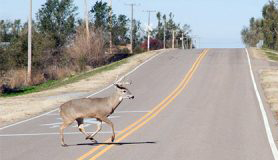TOPEKA — The reality of driving on Kansas roads and highways from now through spring is the possible encounter with a deer, according to Ken Selzer, CPA, Kansas Commissioner of Insurance.
“The national statistics concerning deer-vehicle crashes are sobering,” Commissioner Selzer said. “Kansas is one of the top 20 states in frequency of deer-vehicle mishaps, even though the chances have decreased over the past two years.”
According to State Farm Insurance, which tracks national deer crash information:
- The chance of a driver having a vehicle collision with a deer in Kansas is approximately 1 in 130.
- Nationwide, from July 1, 2017 to June 30, 2018, there were 1.33 million deer-related vehicle accidents.
- The national average cost per vehicle claim from a deer-vehicle collision hovers around $4,300, a number that grows each year.
- Iowa, Missouri and Arkansas have higher frequencies of deer mishaps than Kansas, with Oklahoma, Nebraska and Colorado showing a lower frequency than the Sunflower State.
“To be proactive, Kansas motorists should check with their insurance agents to find out the type of vehicle accident coverage their policies have,” Commissioner Selzer said. “Deer accidents are usually covered under a person’s comprehensive coverage, not collision coverage. You will have to pay your deductible amount in order to receive your company’s coverage. However, if you have liability only for your vehicle coverage, you will probably have to cover the damage repairs out of your own pocket.”
When a vehicle-deer crash occurs, Commissioner Selzer urges Kansas drivers to consider the following:
- Contact your insurance agent or company quickly to begin the claims process.
- If you do hit a deer and are uncertain whether the animal is dead, keep your distance. You might be dealing with an injured, wild animal with sharp hooves.
- If the deer is blocking the roadway and poses a danger to other motorists, you should immediately report the incident to the local law enforcement agency.
- Stay alert, always wear your seat belt and drive at a safe, sensible speed for conditions.
- Watch for the reflection of deer eyes and for deer silhouettes on the shoulder of the road.
- Do not rely exclusively on devices such as deer whistles, deer fences and reflectors to deter deer.
- When driving at night, use high-beam headlights when there is no opposing traffic. The high beams will illuminate the eyes of deer on or near a roadway.
- Brake firmly when you notice a deer in or near your path, but stay in your lane. Many serious accidents occur when drivers swerve to avoid a deer and hit other vehicles or lose control of their cars. Potentially, you will risk less injury by hitting the deer.
- If you see one deer, it is likely there are more nearby.
- If the deer stays on the road, stop on the shoulder, put on your hazard lights and wait for the deer to leave the roadway; do not try to go around the deer while it is on the road.
“If you do have a deer encounter and need some assistance with your vehicle claim, our Consumer Assistance Representatives at the Kansas Insurance Department can help,” said Commissioner Selzer. “Call us at 800-432-2484, or use the online chat feature at our website, www.ksinsurance.org.”

